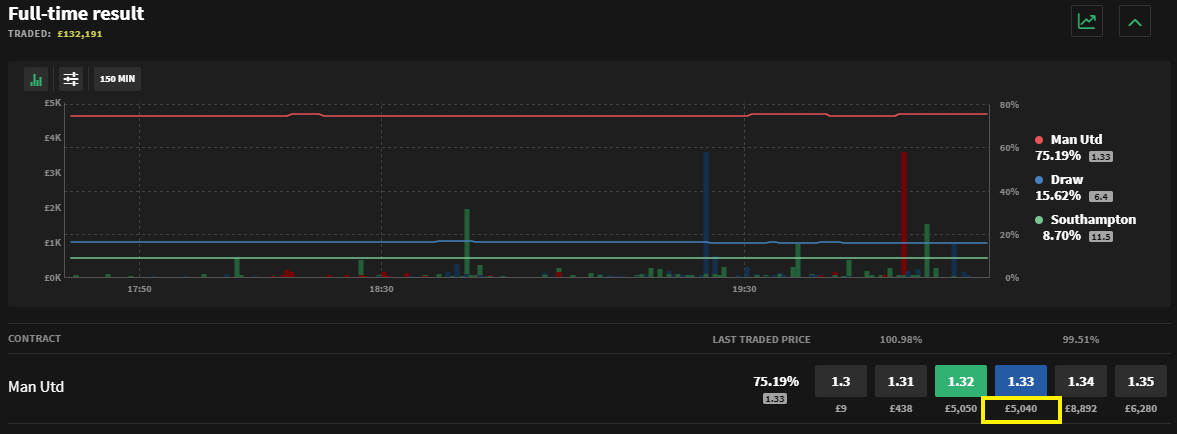What is Liquidity
Understanding liquidity is very important when it comes to matched betting. Overall, the concept is simple and easy to understand.
Liquidity is the maximum amount of money available for you to place your lay bet on the betting exchange.
Betting exchanges aren’t bookmakers, therefore the money available (or liquidity) on these platforms comes from the public.
In the image below, you can see that the amount of liquidity (money available) at the lay odds of 1.33 is £5040.
Note: Liquidity is always displayed underneath the odds on each selection.
This means that we will be able to place up to a maximum of £5040 on our lay stake and it will become instantly matched upon placing that lay bet on the betting exchange. Placing a greater stake than £5040 would result in our lay bet failing to get fully matched, this would be due to there not being enough liquidity on the selection.
Of course, there is no chance whatsoever that we will be placing an enormous lay bet of £5040!
However, in situations where there is a very small amount of liquidity on a selection, this can become a problem.
Note: We always want our lay bets to get fully matched on the exchange.
Below, are 2 different examples of lay bets that we need to place using the betting exchange Smarkets.
Example 1: The matched betting calculator is telling us to place a lay stake of £9.27 at odds of 1.78. 
As you can see, there is a massive £3,116 of liquidity available on the selection that we need to lay on Smarkets (displayed on the image above). We know that we are completely fine to safely place our lay bet of £9.27, this is due to the lay stake amount that we are using (£9.27) being less than the available liquidity (£3116).
Example 2: This time the matched betting calculator tells us we need to place a lay stake of £19.01 at odds of 2.42 on Smarkets.
However, in this example we encounter a problem, the amount of liquidity available on the selection that we need to lay at 2.42 is just £7. This number is less than the £19.01 lay stake that we need to use to lay our bet.
The lack of liquidity available in this example means that our lay bet would not get fully matched, therefore we should not place the lay bet.
As you can see from the 2 examples above, you should only place your lay bet if the amount of liquidity on the exchange is greater than the lay stake that you are using. If you don’t do this and your lay stake is larger than the available liquidity, your bet will either remain fully unmatched or a small portion of your bet could get matched, this is known as getting partially matched.
Either way, this means you will not have successfully covered your back bet.
If this is to happen dont panic, it’s an easy fix. The article below explains all you need to know about this situation.
Learn More About Unmatched and Partially Matched Bets Here.
Note: It is important to remember, the lay stake amount is the number that needs to be less than the available liquidity in order to get your lay bet fully matched. It is NOT the overall liability of your lay bet that needs to be less than the liquidity.
Takeaways
Always remember, it is important to check the available amount of liquidity on the betting exchange before placing a back bet with the bookmaker, doing this will ensure that you are aware that there is enough liquidity on the selection on the betting exchange.
When using the Oddsmatcher you are able to easily filter the software to only display matches that have a certain amount of liquidity.
If you want to learn how to use the highly praised Oddsmatcher feel free to view our guide below.


